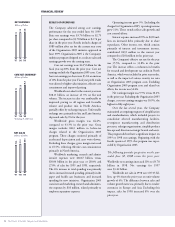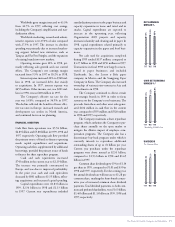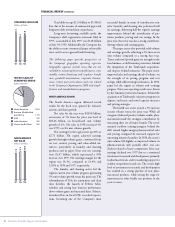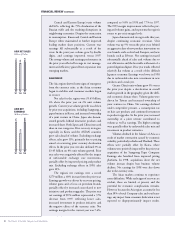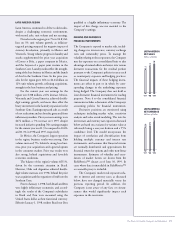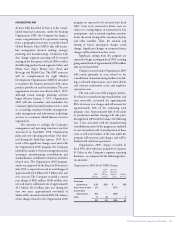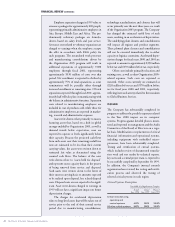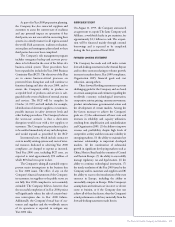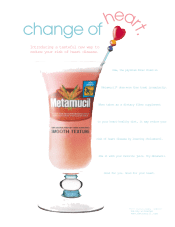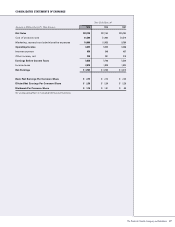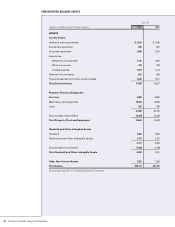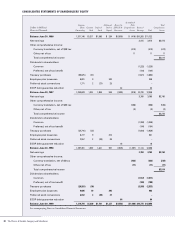Proctor and Gamble 1999 Annual Report Download - page 25
Download and view the complete annual report
Please find page 25 of the 1999 Proctor and Gamble annual report below. You can navigate through the pages in the report by either clicking on the pages listed below, or by using the keyword search tool below to find specific information within the annual report.
The Procter & Gamble Company and Subsidiaries
21
ORGANIZATION 2005
As more fully described in Note 2 to the consol-
idated financial statements, under the heading
Organization 2005, the Company has begun a
major reorganization of its operations, moving
from a geographical structure to product-based
Global Business Units (GBUs) that will stream-
line management decision making, strategic
planning and manufacturing. Consistent with
this change, segment reporting will be restated
starting in the first quarter of fiscal 2000 to reflect
the following product-based segments: Fabric and
Home Care, Paper, Beauty Care, Food and
Beverage and Health Care. The GBU structure
will be complemented by eight Market
Development Organizations (MDOs) intended
to maximize the business potential of the entire
product portfolio in each local market. The new
organization structure was effective July 1, 1999,
although certain strategic planning activities
began effective January 1, 1999. Organization
2005 will also streamline and standardize the
Company’s global essential business services, such
as accounting, employee benefits management,
order management and information technology
services, to a common Global Business Services
organization.
The intention to redesign the Company’s
management and operating structures was first
announced in September 1998. Organization
plans and new operating procedures were final-
ized during the April-June quarter, 1999. As a
result of the significant changes associated with
the Organization 2005 program, the Company
identified a number of restructuring projects that
encompass manufacturing consolidations and
standardization, enrollment reductions and other
related costs. The Organization 2005 program,
which was approved by the Board of Directors in
June 1999, is expected to result in total charges of
approximately $2.6 billion ($1.9 billion after tax)
over six years. The Company recorded a current
year charge of $481 million ($385 million after
tax) and expects additional costs of approximately
$1.5 billion ($1.0 billion after tax) during the
next two years, approximately two-thirds of
which will be incurred in fiscal 2000. The balance
of the charges related to the Organization 2005
program are expected to be incurred after fiscal
2001. Costs to be incurred in future years are
subject to varying degrees of estimation for key
assumptions, such as normal employee attrition
levels, the actual timing of the execution of plans
and other variables. Thus, the amount and
timing of future anticipated charges could
change. Significant changes in estimated future
charges will be disclosed as they occur.
Significant savings from the program are
expected to begin accruing in fiscal 2001, reaching
going annual levels of approximately $900 million
after tax by fiscal 2004.
Charges incurred under Organization 2005
will consist primarily of costs related to the
consolidation of manufacturing facilities (includ-
ing accelerated depreciation, asset write-downs
and contract termination costs) and employee
separation costs.
The non-cash costs of the program, primar-
ily related to manufacturing consolidations and
asset write-offs, accounted for approximately
88% of current year charges and will account for
approximately 30% of the remaining total
program costs. Approximately half of the plant
or production module closings will take place
through fiscal 2000 and the balance the following
year. Costs associated with the manufacturing
consolidation portion of the program are included
in cost of products sold. A small portion of these
costs, as well as the balance of the costs under the
program will represent cash charges, and will be
funded with cash from operations.
Organization 2005 charges recorded in
fiscal 1999, all of which are included in Corporate
& Other in the Company’s segment reporting
disclosure, are comprised of the following before-
tax amounts:
Organization 2005 Fiscal 1999 Charges
Cash Amount
Spent Charged
Total During Against Ending
Charges Period Assets Reserves
Employee
separations $ 45 $(10) $ – $35
Asset write-downs 217 – (217) –
Accelerated
depreciation 208 – (208) –
Other 11 (2) – 9
481 (12) (425) 44





